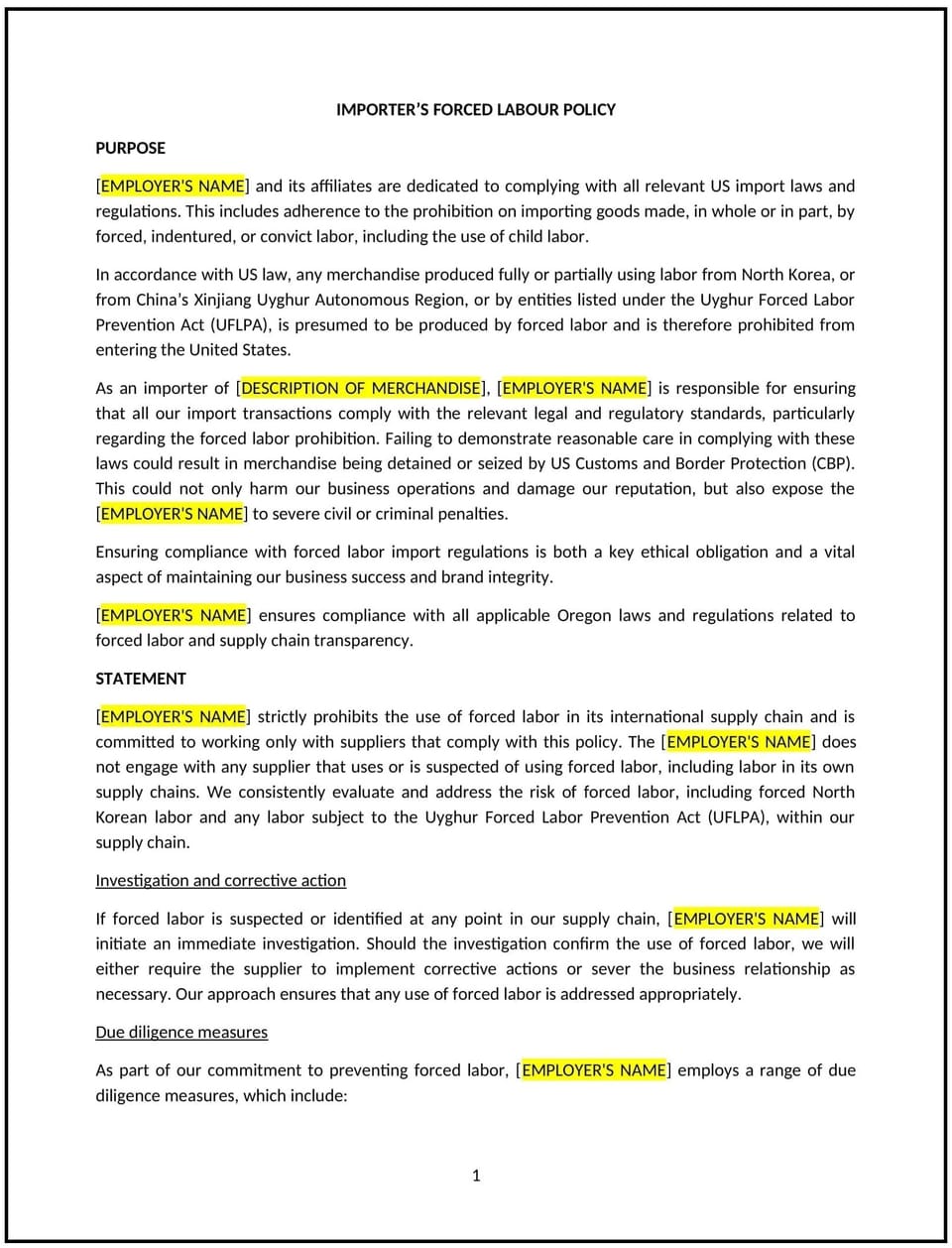Importer’s forced labour policy (Oregon): Free template

Importer’s forced labour policy (Oregon)
This forced labour policy is designed to help Oregon businesses that import goods ensure their supply chains are free from forced or compulsory labour. It outlines steps for due diligence, supplier audits, and compliance with international labour standards.
By implementing this policy, businesses can promote ethical sourcing, reduce legal risks, and align with global best practices for supply chain transparency.
How to use this importer’s forced labour policy (Oregon)
- Define forced labour: Clarify what constitutes forced labour, including coercion, debt bondage, and human trafficking.
- Conduct due diligence: Assess suppliers and supply chains for risks of forced labour.
- Audit suppliers: Regularly evaluate suppliers’ labour practices and working conditions.
- Establish corrective actions: Develop procedures for addressing violations, such as terminating contracts or requiring improvements.
- Train staff: Educate employees on identifying and reporting signs of forced labour.
- Review and update: Evaluate the policy periodically to ensure it aligns with evolving regulations and industry standards.
Benefits of using this importer’s forced labour policy (Oregon)
This policy provides several advantages for Oregon businesses:
- Promotes ethical sourcing: Demonstrates a commitment to fair labour practices and human rights.
- Reduces legal risks: Enhances compliance with laws such as the U.S. Tariff Act and international labour standards.
- Builds reputation: Strengthens the business’s brand by aligning with ethical consumer expectations.
- Improves supply chain transparency: Encourages accountability and traceability in sourcing practices.
- Supports global initiatives: Aligns with international efforts to eradicate forced labour.
Tips for using this importer’s forced labour policy (Oregon)
- Communicate expectations: Share the policy with suppliers and include it in contracts.
- Monitor compliance: Regularly review supplier practices and audit reports.
- Address violations promptly: Take corrective action if forced labour is identified in the supply chain.
- Stay informed: Keep up-to-date with changes in laws and regulations related to forced labour.
- Review regularly: Update the policy as needed to reflect changes in supply chain practices or regulations.
Q: How does this policy benefit businesses?
A: It helps businesses promote ethical sourcing, reduce legal risks, and build a positive reputation.
Q: What should businesses do if forced labour is found in their supply chain?
A: Businesses should take corrective action, such as terminating contracts or requiring suppliers to improve practices.
Q: How often should suppliers be audited?
A: Suppliers should be audited regularly, with frequency depending on the level of risk and the size of the supply chain.
Q: What laws apply to forced labour in supply chains?
A: Relevant laws include the U.S. Tariff Act, which prohibits importing goods produced with forced labour, and international labour standards.
Q: How can businesses ensure suppliers comply with this policy?
A: Businesses can conduct regular audits, provide training, and include compliance requirements in supplier contracts.
This article contains general legal information and does not contain legal advice. Cobrief is not a law firm or a substitute for an attorney or law firm. The law is complex and changes often. For legal advice, please ask a lawyer.


